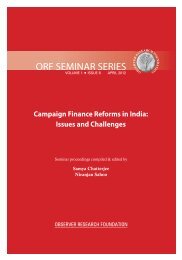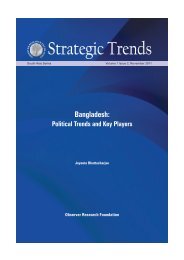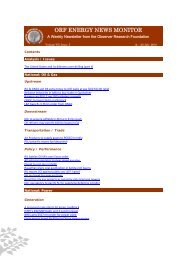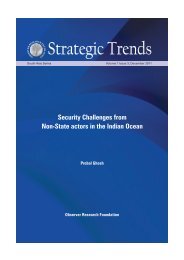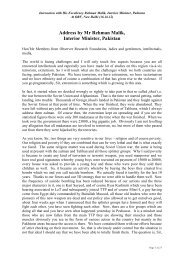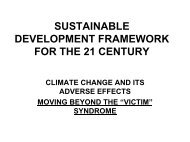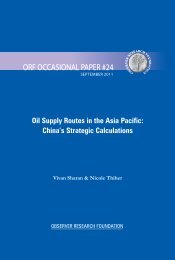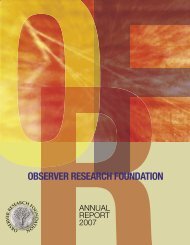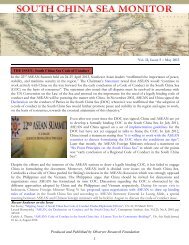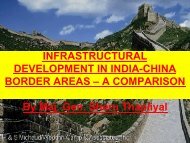Affirmative Action in Private Sector in Malaysia - Observer Research ...
Affirmative Action in Private Sector in Malaysia - Observer Research ...
Affirmative Action in Private Sector in Malaysia - Observer Research ...
Create successful ePaper yourself
Turn your PDF publications into a flip-book with our unique Google optimized e-Paper software.
succeeded <strong>in</strong> pursu<strong>in</strong>g private sector players to adhere to such affirmative/quota regimen?<br />
What are its impact and implications for countries such as India which currently debate on<br />
possibility/feasibility of extend<strong>in</strong>g affirmative action <strong>in</strong> private sector?<br />
Study Methodology<br />
With key objectives of unravel<strong>in</strong>g the strategies, <strong>in</strong>tricacies of implementation processes<br />
particularly the trade-offs between state apparatus and private sector players <strong>in</strong> <strong>Malaysia</strong>, and<br />
to list out key implications for India which is currently debat<strong>in</strong>g to extend affirmative action<br />
<strong>in</strong> private sector 2 , the study broadly followed an exploratory analysis of data on experiences<br />
of private sector participation <strong>in</strong> affirmative action <strong>in</strong> <strong>Malaysia</strong>. The study has relied on data<br />
both from primary and secondary sources. These were primarily accessed from published<br />
government documents and acts New Economic Policy, National Development Policy<br />
(NDP), National Vision Policy (NVP), Industrial Cooperation Act, five-year plans, <strong>in</strong>dustrial<br />
policies, Annual reports of various m<strong>in</strong>istries apart from books, studies, articles, press<br />
clipp<strong>in</strong>gs, political parties manifesto, parliamentary debates and related literature. However,<br />
to compliment and validate the secondary literature, the study undertook fair amount of<br />
fieldworks ma<strong>in</strong>ly through personal <strong>in</strong>terviews with key officials, people’s representatives,<br />
representatives of private sector and other stakeholders related to affirmative programmes<br />
largely to supplement the <strong>in</strong>adequacy <strong>in</strong> exist<strong>in</strong>g empirical data. There were <strong>in</strong>terviews with<br />
lead<strong>in</strong>g entrepreneurs (foreign owned, Bumiputera owned, Ch<strong>in</strong>ese, Indian), politicians, top<br />
civil servants, academics, civil society leaders, media representatives and key policy makers.<br />
Race, Inequality and <strong>Private</strong> <strong>Sector</strong> <strong>in</strong> <strong>Malaysia</strong><br />
<strong>Malaysia</strong> is a multi-racial country comprised of three major ethnic groups the Malays and<br />
other <strong>in</strong>digenous groups together called Bumiputera (Bumiputera and Malay are used<br />
<strong>in</strong>terchangeably <strong>in</strong> this paper) account<strong>in</strong>g for 67 per cent of total population, the Ch<strong>in</strong>ese who<br />
make up about 25 per cent and the Indians 8 per cent of the total population. A ‘plural’ 3<br />
<strong>Malaysia</strong> as it looks today is largely an outcome of British colonial policies (Crouch 1996).<br />
Given colonial ruler’s emphasis on extract<strong>in</strong>g revenues from t<strong>in</strong> m<strong>in</strong><strong>in</strong>g and rubber<br />
plantations which were labour <strong>in</strong>tensive and not many Malays were keen for such strenuous<br />
jobs, the British colonial government organized and permitted a massive <strong>in</strong>flow of low cost<br />
immigrant labour from Ch<strong>in</strong>a and India to meet the high production schedules <strong>in</strong> the<br />
plantation and m<strong>in</strong><strong>in</strong>g sectors. And this facilitated a major change <strong>in</strong> <strong>Malaysia</strong>’s<br />
demography 4 which often raised plenty of concerns from the Malay elites and royals. The<br />
colonial adm<strong>in</strong>istration assuaged such apprehensions by hav<strong>in</strong>g restrictions of immigrants to<br />
certa<strong>in</strong> trade and professions apart from <strong>in</strong>stitut<strong>in</strong>g Malay Special Rights. 5<br />
The colonial rule <strong>in</strong> the form of Malay Special Rights and consequent change <strong>in</strong> demographic<br />
patterns brought major changes <strong>in</strong> political and socio-economic structure of the society 6 and<br />
subsequent variations and changes <strong>in</strong> occupation and location among Malays and non-<br />
Malays. The truth is the Great Brita<strong>in</strong> had established colonial rule for the purposes of trade<br />
and acquisition of raw materials. S<strong>in</strong>ce wage labour from Malay peasantry was hard to come,<br />
the colonial adm<strong>in</strong>istration opened the door for labour immigration which <strong>in</strong> some sense<br />
caused for ethnic division of labour. The ethnic and socio-economic differences as they<br />
existed <strong>in</strong> Malay society at that po<strong>in</strong>t of time were further strengthened by the ‘protection’<br />
measures on the overall Malay Special Rights.



